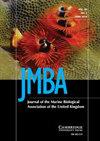Age and growth of bigfin reef squid, Sepioteuthis lessoniana (Cephalopoda: Loliginidae), in Gulf of Mannar Marine Biosphere Reserve, Indian Ocean
IF 0.9
4区 生物学
Q3 MARINE & FRESHWATER BIOLOGY
Journal of the Marine Biological Association of the United Kingdom
Pub Date : 2024-05-17
DOI:10.1017/s0025315424000407
引用次数: 0
Abstract
Statolith growth increments were analysed in the bigfin reef squid,印度洋马纳尔湾海洋生物圈保护区的大鳍礁鱿鱼 Sepioteuthis lessoniana(头足纲:Loliginidae)的年龄和生长情况
对印度东南海岸马纳尔湾生物圈保护区(GOM)中的大鳍礁鱿鱼(Sepioteuthis lessoniana品系B)的体石生长增量进行了分析,以估计其年龄和生长情况。通过线粒体细胞色素 c 氧化酶 I 基因序列确定了 S. lessoniana 系 B 的身份。统计石增量年龄分析表明,研究区野生捕获的 S. lessoniana 乌贼种群增长迅速。雄性乌贼的年龄从61(背幔长95 mm)到220 d(背幔长390 mm)不等,雌性乌贼的年龄从64(背幔长98 mm)到199 d(背幔长340 mm)不等。雄性和雌性的平均日生长率分别为 1.63 和 1.55 mm DML d-1。雄鱼的瞬时增长率从 0.85(210 d)到 4.1%(110 d)不等,雌鱼的瞬时增长率从 0.65(190 d)到 3.7%(110 d)不等。雄鱼和雌鱼的初熟年龄分别为 114 d 和 120 d。回溯计算的孵化期和雌鱼的成熟期表明,S. lessoniana全年都在繁殖,在7-8月和2月有两个明显的产卵高峰;因此,孵化期分布在全年,有两批鱼群存在。根据统计石数据,可以得出结论,在 GOM 的 S. lessoniana 系 B 的潜在寿命可达 7 个月。这一发现与之前根据长度频率数据进行的生长估计相矛盾,后者低估了该物种的真实生长潜力。
本文章由计算机程序翻译,如有差异,请以英文原文为准。
求助全文
约1分钟内获得全文
求助全文
来源期刊
CiteScore
2.30
自引率
8.30%
发文量
68
审稿时长
3-8 weeks
期刊介绍:
JMBA is an international journal, publishing original research on all aspects of marine biology. It includes pioneering work taking place today on major issues concerning marine organisms and their environment. Subjects covered include: ecological surveys and population studies of marine communities; physiology and experimental biology; taxonomy, morphology and life history of marine animals and plants; and chemical and physical oceanographic work. Included with 2010 online subscriptions: Marine Biodiversity Records.

 求助内容:
求助内容: 应助结果提醒方式:
应助结果提醒方式:


